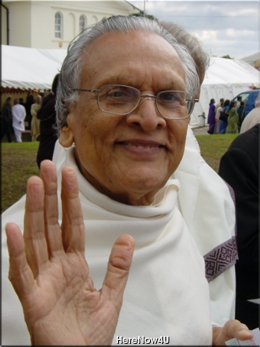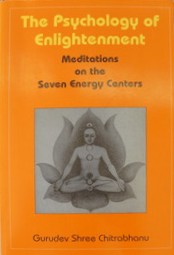My teacher used to tell a story of a learned young man who had read in the scriptures that there existed a marvelous and precious stone. He who held this stone in his possession would be free of all worry. As soon as the young man read this, he left home in search of this wonderful prize. For fifty years, he journeyed throughout the world in vain. Finally, exhausted by his travels, he returned home an old and disappointed man of eighty. Then one day as he was resting on the bank of a river by his home, he noticed a stone sparkling at the water’s edge. When he examined it more carefully, he realized to his astonishment that this was the very stone for which he had searched all his life. What could he do now with such a remarkable gift? He was an old man near the end of his days and he had spent his life searching the world for that which awaited him at his own doorstep.
These seven centers are points of meditation, which will lead us to the prize at our own doorstep - to the inner source of happiness, harmony, and strength, the source of all those things for which we truly yearn. Like the man in the story, we already have this wonderful prize but we do not know it.
The purpose of each meditation is to understand the expense, the special quality, of each energy of experience. If you feel peace, security, creativity, you have reached the goal of the meditation. Do not be disturbed if you have difficulty visualizing. These visual images are simply tools or symbols to help focus the mind; they are not the goals of the meditation.
In reality, meditation is for training this mind. The soul itself does not need it. It is already omnipotent, omnipresent, and omniscient. The mind, on the other hand, is conditioned and limited by accumulated attitudes. It creates duality in us and we find ourselves doing things we aren’t happy about. The unfocused mind is unclear and paranoid; it alienates us from the world around us.
Meditation on these seven centers brings your mind to one-pointedness. These centers are like a map or blueprint. You know that before you construct a house, you must have an outline of it so that the entire houses exist ahead of time on paper. Now, looking at this blueprint, you begin construction. The outline indicates how the finished product will look and how you should go about constructing it. At this stage, it is like children’s game of make-believe. However, to enjoy living in a real house, you must go further than make-believe; you must labor to build it. The symbols of the centers are our outline, our meditative blueprint on which we concentrate our attention in order to reach reality behind the symbol. Like the builder, we must not stop at the blueprint, but go beyond it. We must learn and practice and grow until we experience real change in ourselves. Learning and practice go hand in hand.
The self-confidence you derive from meditation will be reflected in a new feeling if confidence in you by your family, friends, and co-workers. Whether you realize it or not, the subtle vibrations you emanate are inevitably communicated to the people around you. You receive from other what you have already created within your own self. In other words, what you give comes back. Your inner security will create security in others.
With continued practice, meditation will gradually replace your self-doubt with renewed creative inspiration. This force will be felt continuously in all your actions so long as you keep reminding yourself of it. Meditation is not only for twenty short minutes a day - it is to be carried over into the whole day. If you find it difficult to keep the object of meditation in the back of your mind, I suggest you make a note on a small index card for each center of meditation. Carry one of these cards with you in your pocket or purse. Now, just as you check the mirror to see if you look outwardly presentable, glance at the card to see if all is in order inside. Creativity is inevitable when the outer and inner worlds are in order, but it takes time to change a lifetime of habits, which have become firmly rooted in us. Growth and change will occur naturally if you are consistent in your practice.
People turn to the same state from which they started. They are like boats moored to the shore. A breeze may twist and turns them, but you know they are not going anywhere they are weighted down. People who have not loosed themselves from their resentments cannot enjoy progress. No matter where they go, they always come back to the same place.
It is a common belief that findings love a matter of luck; but, I tell you, it is rather question of tying and untying. The moment we untie ourselves from our resentments, we are able to allow love to blossom. Those whose hearts are free of animosity will not lack friends. They may not always find lovers, but they will surely enjoy loving friendship. The West has a tendency to confuse lust with love. People tend to hide their lust under the guise of love, but this is a distortion. Real love has nothing to do with lust; it is an understanding and communication between people, which overcomes any apparent boundaries of age or background.
When I was a child of four and five years old, my good friend was an old man sixty-five. I could bring all my problems to him and he would always give me a right, honest answer. One day when I was four years old, my mother died. I couldn’t understand where she had gone and why she hadn’t returned, so I went to this old man and asked him where she was. It was evening and he pointed out the moon and he starts to me. “Your mother has gone to heaven where she can enjoy all those beautiful stars!” he said.
This only man gave me a new understanding. Everyone else had simply said she was dead and would never come back. I looked up at the stars and the moon and I thought, “Yes! Everything is bright and sparkling, and she is in such a beautiful place?” This old man was a great help to me. We had our own language, our own special communication. He could express things in such a way as to lead me to new insights.
Love can be shared with someone of any race or social position or age because love is a coming together on a level beyond all these external labels. Love is communication between souls - between my real Self and your real Self. The artificial self, which is forever fluctuating between exhilaration and depression, drops away as you focus on the real Self - that ever-expanding, universal love.
Now, moving from the fourth to the fifth center, visualize a scarlet or mauve oval. Gradually expand the space within the oval, breaking all barriers until it is without limitation. Feel that now all energy is available to you whenever your mind becomes distracted, use the mantra aim,[1] which is Sanskrit for “the energy of wisdom, the energy of plenty and purity.” In time, you will begin to experience unity as synonymous with space, with abundance, and with wisdom.
At this point in working on the seven centers, many people find it helpful to practice pranayama breathing. To do this, alternately block one nostril with the thumb and the other with the third finger. Using the ratio 1:4:2, inhale through one nostril, hold the breath, ad exhale through the other nostril. For example, based on this ration, breathe in thorough your right nostril to the count of 4, then retain the breath for 16 counts, and exhale thorough the left nostril, counting 8. Wait approximately 15 seconds and repeat the exercise, inhaling through the left nostril and exhaling through the right. Later, according to your capacity, you may increase the number of counts you breathe and retain the breath based on the ration I have given you.
This breathing exercise practiced at the start of your meditation is an excellent technique for taking oxygen deep into the lungs and into all the blood cells, and releasing the carbon dioxide from the body. It is also useful for calming and focusing the mind. When you have completed this exercise (inhale, retain, exhale) five times, continue with your meditation, feeling you inner purity as you expand into universal space.
Those who meditate on this center will begin to hear the subtle resonance of the universal sound, as their sense of hearing becomes increasingly keen. As the first center is connected with the sense of smell; the second, with the sense of taste; the third, with the sense of sight; and the fourth, with the sense of touch; so the fifth center will refine our sense of hearing.
Focusing on you energy at the throat, you will find that your words have a new authority. The same words, which were previously rejected by others, will now be welcomed by the listening ear. Why? Because the energy behind then will have changed. You will know exactly when, why, and how to speak. You will know when to keep silent. Being in tune with the essence of space, you will offer space to those around you and they will appreciate it. You will be speaking from the realm of purity and truth, and those who listen will recognize it. The one whose hand is no longer grasping and clinging is open to receive the bounty of the universe.
Now, at the fifth center, that person is you.

 Gurudev Chitrabhanu
Gurudev Chitrabhanu
